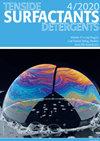阴离子表面活性剂中钌(III)催化六氰高铁酸盐(III)氧化l -苯丙氨酸的动力学研究
IF 1.2
4区 工程技术
Q4 CHEMISTRY, APPLIED
引用次数: 0
摘要
摘要在阴离子十二烷基硫酸钠(SDS)胶束介质中,用[Fe(CN)6]3−对Ru(III)促进的L-苯丙氨酸(L-PheAla)氧化反应进行了动力学研究 nm,对应于[Fe(CN)6]3-使用紫外-可见分光光度计。使用伪一阶条件,通过一次改变一个变量,研究了反应过程作为[Fe(CN)63−]、离子强度、[OH−]、[SDS-]、[Ru3+]、[L-PheAla]和温度的函数。结果表明,[OH−]、[SDS-]和[L-PheAla]是对反应速率有明显影响的关键参数。在Ru(III)、[Fe(CN)6]3−的浓度范围内,以及在[L-PheAla]和[OH−]的低浓度下,反应表现出一级动力学。反应速率随电解质浓度的增加趋势显示出正的盐效应。在SDS胶束介质中的反应速率几乎是在水介质中的10倍。[Fe(CN)6]3−对SDS的CMC没有明显的影响,因为SDS的极性头和[Fe(CN)6]3-−都带负电荷。从K3[Fe(CN)6]和KNO3中获得的K+降低了表面活性剂分子带负电头之间的排斥力,从而降低了SDS的CMC。活化参数也支持外层电子转移机制。本文章由计算机程序翻译,如有差异,请以英文原文为准。
Kinetic study of Ru(III) – catalyzed oxidation of L-phenylalanine by hexacyanoferrate(III) in an anionic surfactant medium
Abstract The kinetic investigation of Ru(III) promoted oxidation of L-phenylalanine (L-PheAla) by [Fe(CN)6]3− has been performed in anionic sodium dodecyl sulfate (SDS) micellar medium by recording the decrease in absorbance at 420 nm corresponding to [Fe(CN)6]3− using an UV–visible spectrophotometer. Using the pseudo-first-order condition, the course of the reaction was studied as a function of [Fe(CN)63−], ionic strength, [OH−], [SDS], [Ru3+], [L-PheAla] and temperature by changing one variable at a time. The results exhibit that [OH−], [SDS], and [L-PheAla] are the crucial parameters that have an appreciable influence on the reaction rate. The reaction exhibits first-order kinetics in concentration ranges of Ru(III), [Fe(CN)6]3− and at low [L-PheAla] and [OH−] concentrations. The incremental trend observed in the reaction rate with electrolyte concentration shows a positive salt effect. The reaction rate is almost 10 times faster in SDS micellar medium than in aqueous medium. [Fe(CN)6]3− has no appreciable effect on the CMC of SDS, since the polar head of SDS and [Fe(CN)6]3− are both negatively charged. The K+ obtained from K3[Fe(CN)6] and KNO3 decreases the repulsion between the negatively charged heads of the surfactant molecules, which decreases the CMC of SDS. The activation parameters also support the outer-sphere electron transfer mechanism.
求助全文
通过发布文献求助,成功后即可免费获取论文全文。
去求助
来源期刊

Tenside Surfactants Detergents
工程技术-工程:化工
CiteScore
1.90
自引率
10.00%
发文量
57
审稿时长
3.8 months
期刊介绍:
Tenside Surfactants Detergents offers the most recent results of research and development in all fields of surfactant chemistry, such as: synthesis, analysis, physicochemical properties, new types of surfactants, progress in production processes, application-related problems and environmental behavior. Since 1964 Tenside Surfactants Detergents offers strictly peer-reviewed, high-quality articles by renowned specialists around the world.
 求助内容:
求助内容: 应助结果提醒方式:
应助结果提醒方式:


